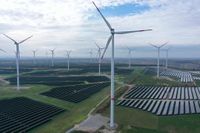America is in the midst of an artificial intelligence (AI) revolution, and its effects are rippling through nearly every sector of the economy. But perhaps nowhere is this transformation more evident than in the nation’s power grid, which is straining under the weight of a rapidly expanding data center industry. As AI and cloud computing continue their explosive growth, the country faces a critical challenge: how to keep the lights on for the digital age without overwhelming the grid or sacrificing environmental goals.
On August 18, 2025, the urgency of the situation was laid bare. According to Benzinga, data centers now account for a staggering 5% of total U.S. electricity demand—a figure expected to double within five years. That’s not just a blip on the radar; it’s a seismic shift. Vacancy rates for data centers have plummeted to 2.3%, creating a fierce mismatch between what companies need and what’s actually available. In fact, North America may see up to $1 trillion invested in new data center development between 2025 and 2030, with hyperscale giants like Amazon Web Services, Microsoft Azure, and Google Cloud leading the charge.
But this digital gold rush comes at a price. The U.S. Energy Information Administration projects record-breaking electricity consumption in 2025 and 2026, while ICF International warns that overall demand could jump by 25% by 2030. McKinsey & Co. estimates that data center power needs could add about 460 terawatt-hours of demand by 2030—triple current consumption levels. And it’s not just about electricity. Water usage for cooling these massive server farms is expected to soar by 170% over the same period, raising fresh environmental concerns.
This crunch is already being felt in places like Ashburn, northern Virginia, just outside Washington, DC. As The Economist reports, this unassuming suburb is home to the world’s largest cluster of data centers, which last year consumed more than a quarter of the power produced by Virginia’s main electrical utility. The expansion is creating economic pressures that ripple far beyond the tech sector, squeezing other industries and raising questions about how to balance innovation with sustainability.
Speculative developers are flooding utility systems with requests for new connections, while legitimate projects face years-long backlogs. According to Data Center Knowledge, this bottleneck has become the single biggest constraint on growth. The stakes couldn’t be higher, with the financial future of the entire digital economy hanging in the balance.
Recognizing these challenges, policymakers have started to act. Congress recently passed the "One Big Beautiful Bill" Act, and the White House unveiled its AI Action Plan, both aimed at supporting the industry’s growth. Yet, as experts caution, there are limits to what federal policy can achieve. The sector remains largely self-driven, with companies pouring billions into their own infrastructure to keep up with AI’s insatiable appetite for data and processing power. Some industry leaders worry that efforts to slow AI regulation or delay energy sustainability measures could backfire, making the problem worse in the long run.
With the grid under strain, attention is turning to solutions—both technological and policy-driven. During Climate Week NYC 2025, Newsweek will host its "Powering Ahead" summit at its headquarters in New York City. The event will bring together leaders from power providers and utility companies, such as AES, Bloom Energy, Duke Energy, Hitachi Energy, Octopus Energy, PG&E, Rondo Energy, Schneider Electric, and sonnen, to discuss the future of clean energy. The focus? Innovations in renewable sources, battery energy storage, and virtual power plants to help meet surging demand. Panelists will also tackle the challenge of powering the next generation of AI, which requires gigawatts of electricity to train and operate new models.
“AI will likely demand a mix of more power from the grid, on-site power generation and energy storage, and smarter systems to manage the energy requirements at data centers,” Newsweek notes. It’s a tall order, but one that’s attracting a wave of investment and innovation.
One area seeing renewed interest is nuclear energy. As highlighted by Zacks Investment Research, nuclear power is increasingly viewed as a key solution to meeting rising global electricity demand while reducing carbon emissions. President Donald Trump has issued four executive orders aimed at modernizing regulatory frameworks, expediting reactor testing and approvals, leveraging nuclear technology for national security, and expanding the domestic nuclear industrial base. The goal: increase U.S. nuclear capacity from about 100 gigawatts in 2024 to 400 gigawatts by 2050—a fourfold jump.
This policy shift is fueling growth among nuclear energy original equipment manufacturers (OEMs) like Mirion Technologies, BWX Technologies, and GE Vernova. All three reported strong second-quarter 2025 earnings, with Mirion Technologies projecting 7% to 9% revenue growth for the year and a focus on radiation safety technologies vital for next-generation reactors. BWX Technologies, benefiting from robust federal demand and a growing pipeline in both government and commercial operations, saw its backlog swell to $6 billion—up 70% year over year. Meanwhile, GE Vernova is betting big on small modular reactors (SMRs), with its joint venture, GE Hitachi Nuclear Energy, poised to deploy the BWRX-300 SMR in Canada by 2029 and expand internationally through partnerships in Finland, Sweden, the UAE, and the UK.
These investments are more than just numbers on a balance sheet—they represent a fundamental shift in how America powers its digital future. As data centers become ever more central to the economy, ensuring a reliable, sustainable supply of electricity has become a national priority. But the path forward is anything but straightforward. Resource shortages, infrastructure delays, and public opposition could slow projects or drive up costs. And as Data Center Knowledge cautions, “Industry experts caution that resource shortages, infrastructure delays, and public opposition could slow projects or increase costs.”
Meanwhile, the environmental stakes are growing. The rise of electric vehicles (EVs) and the push to reduce plastic waste are adding new layers of complexity to the energy equation. As Newsweek points out, the production of plastics now accounts for about 5% of global greenhouse gas emissions—more than the aviation sector. Addressing these challenges will require coordinated action across sectors, from automakers retooling for EV production to policymakers crafting smarter packaging and recycling policies.
What’s clear is that the AI boom isn’t just a technology story—it’s an energy story, a business story, and an environmental story all rolled into one. The choices made today will shape the nation’s economic and ecological landscape for decades to come. As the world’s largest economy races to keep pace with the demands of the digital era, the power grid’s ability to adapt may well determine the future of American innovation.





